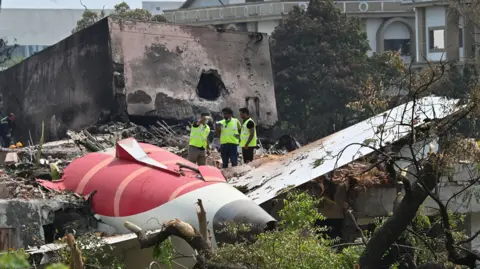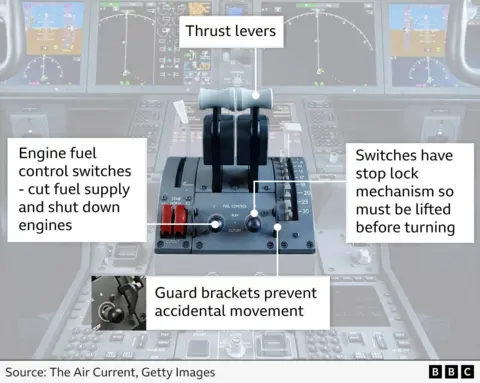Theo LeggettInternational Business Cellecten
 Getty Images
Getty ImagesAlmost five months after the plane crash in India that killed 260 people, the investigation has become embroiled in controversy – the most innovative of its kind.
Flight 171 was en route to London from Ahmedabad in western India on 12 June. Crashed into a building just 32 seconds after clearing.
An interim report was released in July, but critics argued it unfairly focused on the pilots’ actions, diverting attention from a possible fault with the plane.
On Friday, a judge at India’s Supreme Court insisted that the plane’s captain was innocent.
His comments come a week after the airline’s boss insisted there were no problems with the plane.
During a panel discussion at the Aviation India 2025 summit in New Delhi in late October, Chief Enecutive Campbell Wilson claimed that the families involved, for the families of those involved, for the families of those involved, and the staff “.
But he stressed that the initial investigation by Indian officials, which began with a preliminary report, “showed that there was nothing wrong with the aircraft, the engines or the operation of the aircraft”.
He added that though Air India was working with investigators it was not directly involved.
Since the accident happened in India, the investigation is led by the Air Accident Investigation Bureau of the country (AAIB). However, since its aircraft and engines are designed and built in America, US officials also share.
A month after the accident, the AAIB published a preliminary report. This is the standard procedure for major accident investigations and is meant to provide a summary of known facts at the time of publication.
The report will often draw on information gleaned from crash site inspections, for example, as well as basic flight data downloads. It doesn’t usually make firm conclusions about the cause of the accident.
However, the 15-page report on Air India 171 proved controversial. Most of this is due to the content of two short paragraphs.
First, these seconds after the stop, the fuel cutoff switches – usually used to start the engines before the flight
It must have deprived the engines of gasoline, causing them to disappear immediately. The switches were flipped back to restart the engines, but it was too late to prevent disaster.
It said: “On the recording of the rooster’s sound, one of the pilots is heard asking the others why he cutoff. The other pilot did not do the same.”

That indirectly reported exchange is highly speculative about the role of the two pilots, Captain Sumemeet Sabharwal and his first officer Clive Kuner, who were flying the plane at the time.
A former chairman of the National Transportation Safety Board, Robert Sumwalt, claimed that the report showed “It’s not a problem with the plane or the engines”.
“Someone deliberately shut off the fuel, or somehow or other it was a slip that they didn’t covertly shut off the fuel?” He said in an interview with the US Network CBS.
Indian Aviation Consultant Consultant explains loudly.
“I don’t want to use the word. I heard the pilot had some medical history and … it could happen,” he said.
Mike Andrews, a lawyer acting for the families of the victims, wondered how the release of information “led the pilots without all the information”.
“An aircraft like this – that’s very complex – there are a lot of things that can go wrong,” he explained.
“To grab two small, decontextualxtuation pieces of information, and automatically blame the pilots for suicide and mass murder … is unfair and wrong.”
This view was echoed by Capt. Amit Singh, Trounder of the Secies Buster Foundation, an organization based in India that works to promote a culture of safety in Aviation.
He produced a report claiming that the available evidence “strongly supports the theory of an electrical disturbance as the cause of the engine shutdown” that led to the disaster.
He believed that an electrical fault could cause the Digital Engine Digital Control (Fadec), a computerized system, to prevent the shutdown by cutting off the fuel supply.
While the flight data recorder, he suggested, could have registered the order to close the fuel supply, instead of any physical movement of the cockpit.
That is, the switches themselves may not have been touched at all, until the pilots tried to restart the engines.
Capth also challenged the manner in which the investigation was conducted by the Supreme Court of India.
He told the BBC how the preliminary retrial was framed because it “appears to suggest pilot error, without disclosing all the technical anomalies that occurred during the flight”.
While the Supreme Court itself has already commented on the issue.
It considered a petition filed by Pushkarraj Sabharwal, the father of Capt. Sumeet Sabharwal. The 91-year-old is seeking an independent judicial inquiry into the tragedy.
“It’s not very good, this crash, but you don’t have to carry this burden of blaming your son. No one blames him for anything,” Suralia Kant told him.
A further hearing is expected on 10 November.
‘Flat error’
The theory that an electrical fault may have caused the accident is supported by the US-based Foundation for Aviation Safety (FAS).
Its founder Ed Pierson, a former senior manager of Boeing, was once very critical of the safety standards of the US aerospace giant.
He believed the preliminary report was “way too poor … shamefully inadequate”.
His organization spent time investigating reports of electrical issues on board 787s. They include water leaks in wiring bays, which were previously detected by the US regulator, the Federal Aviation Authority. Concerns are also made in other halls.
“There are a lot of what we consider to be electrical freaks on the plane, for them to go out and to all intents and purposes check out the pilots without fault,” he said.
He believes there was a deliberate attempt to divert attention from the plane and the pilots.
FASS calls for the collective reform of the current methods of checking the Air Air Air Air Air Air Air Air Air Air Air Air Air Air Air Air Air Air Air Air Air Air Air Air Air Air Air Air Air Air Air Air Air Air Air Air Air Air Air Air Air Air Air Air Air Air Air Air Air Air Air Air Air Air Air Air Air Air Air Air Air Air Air Air Air Air Air Air Air Air Air Air Air Air Air Air Air Air Air Air Air Air Air Air Air Air Air Air Air Air Air Air Air Air Air Air Air Air Air Air Air Air Air Air Air Air Air Air Air Air Air Air Air Air Air Air Air Air Air Air Air Air Air Air Air Air Air Air Air Air Air Air Air Air Air Air Air Air Air Air Air Air Air Air Air Air Air Air Air Air Air Air Air Air Air Air Air Air Air Air Air Air Air Air Air Air Air Air Air Air Air Air Air Air Air Air Air Air Air Air Air Air Air Air Air Air Air Air Air Air Air Air Air Air Air Air Air Air Air Air Air Air Air Air Air Air Air Air Air Air Air Air Air Air Air Air Air Air Air Air Air Air Air Air Air Air Air Air Air Air Air Air Air Air Air Air Air Air Air Air Air Air
‘Keeping an Open Mind’
Mary Schiavo, a lawyer and former inspector general of the US Department of Transportation, disagrees that the pilots were deliberately placed under cover.
He thinks that the preliminary report is wrong, but only because the investigators are under strong pressure to provide information, with worldwide attention.
“I think they’re in a hurry, because it’s a terrible accident and the whole world is watching. They’re in a hurry to push something,” he said.
“Then, I think, the whole world jumped to conclusions and then said, ‘It’s the pilot’s suicide, it’s intentional’.
“If they had to do it all over again, I don’t think they would put the little snippets from the cockpit voice recording,” he said.
His own view is that “a computer or mechanical failure … is the most likely scenario”.
International rules for air accident investigations stipulate that a final report must appear within 12 months of the event, but this is not always followed. However, until this is published, the true causes of the accident will remain unknown.
A former air accident investigator who spoke to the BBC emphasized the importance of “keeping an open mind”, until the process is over.
Boeing has always maintained that the 787 is a safe aircraft – and it has a solid record.
The company told the BBC of India’s AAIB’s delay in providing information about the investigation.


